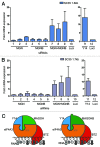Two mammalian MAGOH genes contribute to exon junction complex composition and nonsense-mediated decay
- PMID: 23917022
- PMCID: PMC3817150
- DOI: 10.4161/rna.25827
Two mammalian MAGOH genes contribute to exon junction complex composition and nonsense-mediated decay
Abstract
The exon junction complex (EJC) participates in the regulation of many post-transcriptional steps of gene expression. EJCs are deposited on messenger RNAs (mRNAs) during splicing and their core consists of eIF4A3, MLN51, Y14, and MAGOH. Here, we show that two genes encoding MAGOH paralogs (referred to as MAGOH and MAGOHB) are expressed in mammals. In macrophages, the expression of MAGOHB, but not MAGOH mRNA, increases rapidly after LPS stimulation. Both MAGOH proteins interact with other EJC components, incorporate into mRNA-bound EJCs, and activate nonsense-mediated decay. Furthermore, the simultaneous depletion of MAGOH and MAGOHB, but not individual depletions, impair nonsense-mediated decay in human cells. Hence, our results establish that the core composition of mammalian EJCs is more complex than previously recognized.
Keywords: EJC; MAGOHB; NMD; gene duplication; mago nashi homolog.
Figures





Similar articles
-
Association of the breast cancer protein MLN51 with the exon junction complex via its speckle localizer and RNA binding module.J Biol Chem. 2004 Aug 6;279(32):33702-15. doi: 10.1074/jbc.M402754200. Epub 2004 May 27. J Biol Chem. 2004. PMID: 15166247
-
Multifaceted roles of MAGOH Proteins.Mol Biol Rep. 2023 Feb;50(2):1931-1941. doi: 10.1007/s11033-022-07904-1. Epub 2022 Nov 17. Mol Biol Rep. 2023. PMID: 36396768 Review.
-
Mutations equivalent to Drosophila mago nashi mutants imply reduction of Magoh protein incorporation into exon junction complex.Genes Cells. 2022 Jul;27(7):505-511. doi: 10.1111/gtc.12941. Epub 2022 Apr 25. Genes Cells. 2022. PMID: 35430764
-
Trypanosomes lack a canonical EJC but possess an UPF1 dependent NMD-like pathway.PLoS One. 2025 Mar 7;20(3):e0315659. doi: 10.1371/journal.pone.0315659. eCollection 2025. PLoS One. 2025. PMID: 40053537 Free PMC article.
-
The Physiological Roles of the Exon Junction Complex in Development and Diseases.Cells. 2022 Apr 1;11(7):1192. doi: 10.3390/cells11071192. Cells. 2022. PMID: 35406756 Free PMC article. Review.
Cited by
-
Adult Deletion of SRF Increases Epileptogenesis and Decreases Activity-Induced Gene Expression.Mol Neurobiol. 2016 Apr;53(3):1478-1493. doi: 10.1007/s12035-014-9089-7. Epub 2015 Jan 31. Mol Neurobiol. 2016. PMID: 25636686 Free PMC article.
-
Calpain-6 confers atherogenicity to macrophages by dysregulating pre-mRNA splicing.J Clin Invest. 2016 Sep 1;126(9):3417-32. doi: 10.1172/JCI85880. Epub 2016 Aug 15. J Clin Invest. 2016. PMID: 27525442 Free PMC article.
-
Translational repression of NMD targets by GIGYF2 and EIF4E2.PLoS Genet. 2021 Oct 19;17(10):e1009813. doi: 10.1371/journal.pgen.1009813. eCollection 2021 Oct. PLoS Genet. 2021. PMID: 34665823 Free PMC article.
-
Innate and Adaptive Immune Genes Associated with MERS-CoV Infection in Dromedaries.Cells. 2021 May 23;10(6):1291. doi: 10.3390/cells10061291. Cells. 2021. PMID: 34070971 Free PMC article.
-
The exon junction complex in neural development and neurodevelopmental disease.Int J Dev Neurosci. 2016 Dec;55:117-123. doi: 10.1016/j.ijdevneu.2016.03.006. Epub 2016 Apr 9. Int J Dev Neurosci. 2016. PMID: 27071691 Free PMC article. Review.
References
Publication types
MeSH terms
Substances
LinkOut - more resources
Full Text Sources
Other Literature Sources
Molecular Biology Databases
